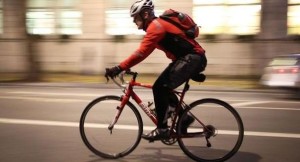Our Top Tips on cycling to work safely
08 June 2016

If you’re me and you cycle to work every day, you’ll probably have colleagues and family members telling you how brave you are as it’s generally thought that those who choose 2 wheels instead of 4 to get to work have a death wish. However government finings in 2013 showed that you are over x2 more at risk whilst walking to work than cycling to work. ( Source)
Get the right gear: First of all make sure you have the proper gear. This might seem obvious but the amount of people I see on my cycle to work who don’t own or wear a helmet is frightening and you’re just unnecessarily increasing without one. You don’t have to wear a fluorescent high-vis jacket but bright clothes will help you to be seen on the road. A good pair of lights are also a must, try to get an LED pair as they tend to last longer and the flashing settings will help draw attention to you.
Be confident: It’s important to remember that you have as much right to be on the road as a car does. Confidence breeds confidence and a driver is much more likely to give you respect if you ooze confidence. When riding on the road make sure you don’t cycle in the gutter and always keep at least 75 cm away from the kerb. This will not only help drivers see you but it should also stop drivers going for risky overtakes when there really isn’t the room to do so.
Assert yourself: At junctions or feeder lanes. When cycling and approaching a junction the best thing you can do is eyeball a driver, especially if he is looking to pull out across you. By eyeballing a driver you’ll make sure he’s seen you and it will also make him think twice about pulling out. You’ll also be able to see from his motions what he’s looking to do. If his driving style appears to be aggressive move out slightly towards the middle of the lane. This will make you easier to see and also allow you to go round the front of the car if the driver is edging out. Regardless of whether it’s dark or not always keep your headlight on a flashing setting. This will help draw the driver’s attention. The other thing to do, especially with a feeder road is to hold your position. It’s quite easy to drift off the actual road and then find yourself in a compromised position once the feeder turn off or feeder lane has come to an end.
Signal properly: It’s important that you signal properly and like you mean it! By signalling properly you let drivers know exactly what you plan to do and where you plan to go. If you need to turn right make sure you start signalling early and begin to move into the middle of the road. Failure to do so could see cars continue to overtake you and trap you on the inside.
Undertake & Overtake with caution:, We've heard a few people and read a few articles say that it’s ok to undertake if traffic is stationary. However in our opinion this needs careful consideration. Drivers don’t tend to check their inside mirrors and there is absolutely no chance of a bus or lorry seeing you on the inside. If there is an emergency vehicle coming the traffic will need to shunt over to the left and you could find yourself under a lorry or bus. Plus you will be amased how often a passenger jumps out of a car on the inside, assuming there is nothing coming up from behind!
When overtaking it’s important to stay observant of your surroundings. Where possible make sure you leave enough room to adjust if a door opens in front of you. At traffic lights it's always best to overtake all the stationary traffic and position yourself at the front of the queue. This will make you seen as well as negating the risk of being knocked off by vechiles turning left.
Happy Cycling - Protect Your Bubble